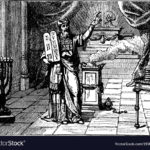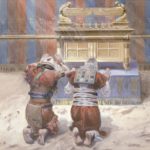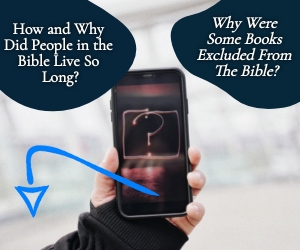What is the significance of the veil being torn at the crucifixion of Christ? What does this tell us?
The Easter Story
The death and resurrection of Jesus Christ — what we often refer to as the story of Easter — is the most important event in human history. For that reason, most people are familiar with the major details of the story:
Jesus taught His disciples during the Last Supper.
His prayer in the Garden of Gethsemane (and the failure of the disciples to pray with Him).
His betrayal and arrest in that garden, all orchestrated by Judas Iscariot and the religious leaders.
His trial before the Sanhedrin.
His trial before Roman officials, including Pontius Pilate.
His crucifixion, His death, His burial, and His resurrection on the morning of the third day.
Even though we’re familiar with a story, there are often minor details that warrant some additional exploration. That’s certainly the case with this small nugget of information from the Gospel of Luke:
“It was now about the sixth hour, and there was darkness over the whole land until the ninth hour, while the sun’s light failed. And the curtain of the temple was torn in two” (Luke 23:44-45). (Emphasis added)
On the surface, it seems as if darkness covering the whole land for hours in the daytime would be a much more significant event than the curtain or veil being torn in the temple, however, if we want to gain a full appreciation of what happened at the moment of Jesus’ death, we need to check back in the Old Testament and understand why that curtain was in the temple in the first place.
The Old Testament Veil
The origin of this particular curtain goes all the way back to Moses in the Book of Exodus. God gave specific instructions on how Moses was to construct the tabernacle, which was the primary place of worship for God’s people. Exodus 26:31-35 gives us the details:
“And you shall make a veil of blue and purple and scarlet yarns and fine twined linen. It shall be made with cherubim skillfully worked into it. And you shall hang it on four pillars of acacia overlaid with gold, with hooks of gold, on four bases of silver. And you shall hang the veil from the clasps, and bring the ark of the testimony in there within the veil. And the veil shall separate for you the Holy Place from the Most Holy. You shall put the mercy seat on the ark of the testimony in the Most Holy Place. And you shall set the table outside the veil, and the lampstand on the south side of the tabernacle opposite the table, and you shall put the table on the north side.”
The Presence of God
The main reason the tabernacle was so important to the Israelite community was because it represented the presence of God. The fact is, God is omnipresent, meaning He is everywhere at all times, but being limited finite creatures, we can’t really understand omnipresence, but in ancient times, God was more fully present in the Tabernacle. Specifically, His presence was concentrated in the innermost room of the tabernacle, which was called the Most Holy Place or the Holy of Holies.
As you can imagine, this made the Most Holy Place a seriously restricted part of the Israelite community. Only the High Priest was allowed to enter that space — and he could only do so once every year on the Day of Atonement. The penalty for entering God’s presence without authorization was instant death as it says, “The LORD spoke to Moses after the death of the two sons of Aaron, when they drew near before the LORD and died, and the LORD said to Moses, “Tell Aaron your brother not to come at any time into the Holy Place inside the veil, before the mercy seat that is on the ark, so that he may not die. For I will appear in the cloud over the mercy seat” (Lev 16:1-2). They were allowed only one mistake, and it was over! 
The Tabernacle
We must remember that the Tabernacle was a large tent, so having a thick curtain was the closest thing resembling a wall and a door. The curtain’s function was to separate the Most Holy from the unholy (us!). The veil separated the Most Holy from the other areas of the tabernacle where the priests performed other duties, but also away from the Israelite community as a whole. Essentially, the curtain was a physical representation of the separation between God and mankind — between God’s holiness and the sinful nature of human beings. When King Solomon replaced the tabernacle with the Temple (a more permanent structure made from stone and gold), the curtain still remained where it was before. Even in Jesus’ time, the curtain still separated God’s presence from everyone else but the high priest.
The Veil is Torn
Moving back to the crucifixion, it’s clear from Luke’s record that the curtain in the temple was connected to a supernatural event — including an earthquake and three hours of unnatural darkness. Matthew’s Gospel adds another detail: “And behold, the curtain of the temple was torn in two, from top to bottom. And the earth shook, and the rocks were split. The tombs also were opened. And many bodies of the saints who had fallen asleep were raised” (27:50-52).
Keep in mind, the temple during Jesus’ day was a large building with large rooms. This means a large curtain was needed to separate the Holy of Holies and the common or unholy. Sources from the time indicate that this particular “curtain of the temple” was 60 feet long, 30 feet wide, and thick as a man’s palm. Tradition says it took 300 men to lift this curtain when it was wet after being washed.
 To be clear, this was no ordinary living room drape! It would have taken a tremendous amount of force to rip the curtain in half. And the fact that it was torn “from top to bottom” is often interpreted to mean that God Himself did the ripping. The destruction of the curtain was a supernatural act, similar to the darkness, the earthquake, and the resurrection of the dead. The big question is why? Why did God tear the curtain, and why did the Gospel writers include this particular detail in their record of the Easter story?
To be clear, this was no ordinary living room drape! It would have taken a tremendous amount of force to rip the curtain in half. And the fact that it was torn “from top to bottom” is often interpreted to mean that God Himself did the ripping. The destruction of the curtain was a supernatural act, similar to the darkness, the earthquake, and the resurrection of the dead. The big question is why? Why did God tear the curtain, and why did the Gospel writers include this particular detail in their record of the Easter story?
Conclusion
The reason the temple curtain or veil was torn was because of Jesus’ death on the cross. He paid the penalty for the sins of all people; His death atoned for our sins, therefore, there was no longer an innate separation between God and humanity. Jesus’ sacrifice granted us access to God’s presence in a way that was previously forbidden and it made the sacrificial system obsolete. In short, just as the curtain was a physical representation of our separation from God, the destruction of the curtain represented the removal of that separation. Because of Jesus, we can receive forgiveness for our sins and be welcomed into God’s saving presence. That is the message of Easter. That is why the veil was torn.
About the author: Diane H. Wong, a content writer at Do My Writing. She worked as an SEO specialist for more than 5 years. This has helped her to be able to estimate and analyze the business sphere much better.
Here is some related reading for you: Tearing of the Temple Curtain: Why Was This Significant?
Resource – Scripture quotations are from The Holy Bible, English Standard Version® (ESV®), Crossway Bibles. (2007). ESV: Study Bible: English standard version. Wheaton, Ill: Crossway Bibles. Used by permission. All rights reserved.









 Welcome to What Christians Want To Know! The mission of this site is to equip, encourage, and energize Christians. Look for regular updates including Bible Verses, Bible Stories, Christian Quotes, Christian Answers, and much more. Find out
Welcome to What Christians Want To Know! The mission of this site is to equip, encourage, and energize Christians. Look for regular updates including Bible Verses, Bible Stories, Christian Quotes, Christian Answers, and much more. Find out 









